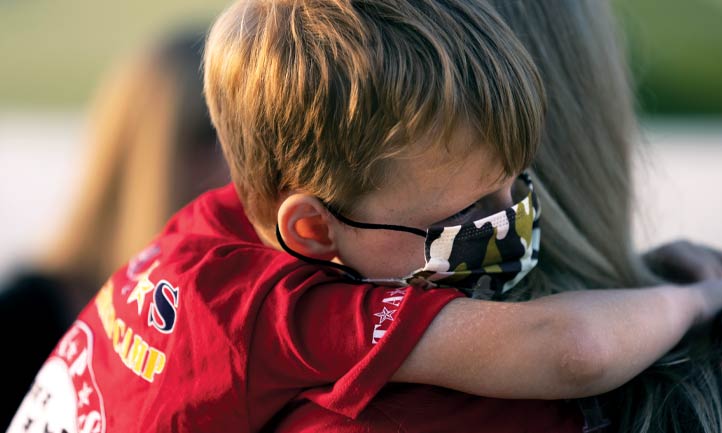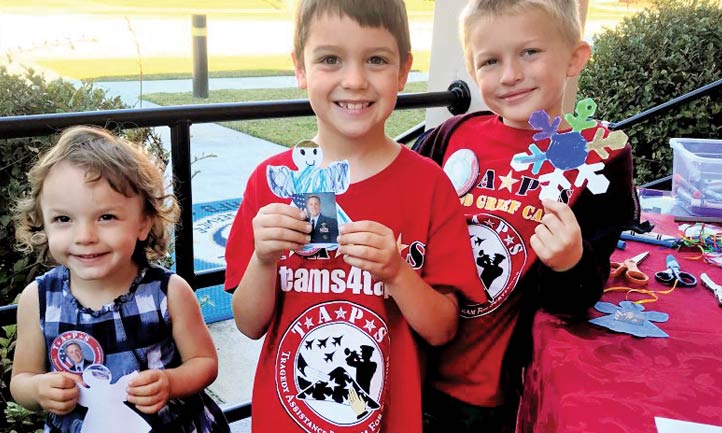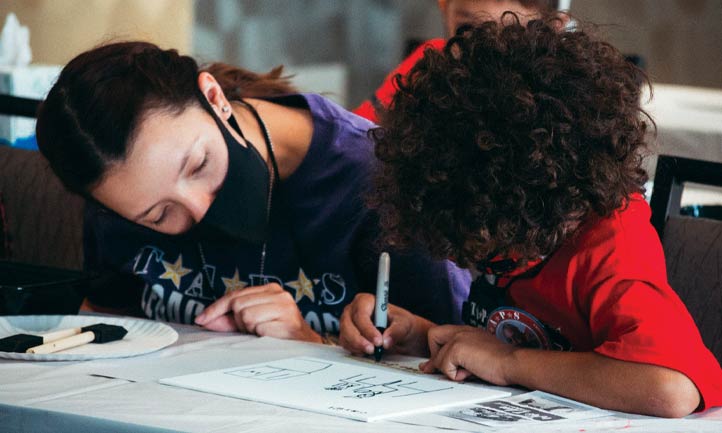Kids, Grief, and COVID-19
Author: Linda Goldman

Children and teens have had their world turned inside out during the coronavirus pandemic. The familiar has turned foreign, the expected has vanished, and the world as kids knew it pre-COVID-19 has transformed into a surreal new normal. Overwhelmed by virtual classes, home quarantine, cleanliness and health pressures, isolation from friends and school, financial insecurity, racial unrest, political chaos, COVID-19 illness, and death, young people face enormous challenges impacting their life.
Childhood Losses during the Pandemic
A brief glance at the following childhood losses highlights what young people are experiencing during the pandemic, especially the loss of safety and protection by the adult world.
- Loss of Relationships
- Loss of Environment
- Loss of Skills and Abilities
- Loss of Self and Self-esteem
- Loss of External Objects
- Loss of Habits and Routines
- Loss of Privacy
- Loss of Protection by the Adult World
- Loss of Future and Safety
- COVID-19 Illness and Death Challenges
Children and families are experiencing unprecedented challenges during the coronavirus. The difficulties caused by social distancing may prohibit kids from visiting loved ones in the hospital, hugging their person, or saying goodbye in person. Facetime, phone chats, and Zoom meetings have become virtual antidotes. Yet, not having personal hospital visits can be a great loss, provoking anxiety and disturbing imaginings of what is happening to a loved one.
Creating an open-ended dialogue with children about illness or death begins with adults finding age-appropriate language to use. We can define death for children as when the body stops working. Usually, people die when they are very, very, old; very, very sick; or doctors and nurses cannot make their very, very injured bodies work again.
Developmental Stages for Young People
Children grieve differently at different developmental stages. The Swiss educator Piaget explains children’s cognitive understanding of death through the following developmental stages at approximate ages, which describe age appropriate developmental concepts surrounding the grief process:

- Sensorimotor Stage, Ages 0 to 2: A child’s concept of death is characterized by “out of sight, out of mind.”
- Preoperational Stage, Ages 2 to 7: A child’s concept of death includes magical egocentricity, reversibility, and causality.
- Concrete Operations, Ages 7 to 12: A child’s concept of death is curious and realistic.
- Formal Operations, Ages 13 and Up: An adolescent’s concept of death is self-absorbed, and they see death as remote and rely on their peers for support.
Toddlers and preschoolers might not understand that death is permanent. Using clichés such as “Dad went on a long trip” or “We lost Aunt Jane” may leave them waiting for their person to be back. Emotions can range from temper tantrums to withdrawal because of difficulty verbalizing fear or sadness.
Young children often feel death is reversible. For example, Joey wrote a letter to Grandfather after he died and waited every day for a response. Magical thinking, causality, and egocentricity characterize this age group, with kids feeling they magically cause a death. A six-year-old may explain, “If only I could have been with mom in the hospital. I could have saved her.”
Pre-teens know that death is permanent. Their fear of death and the pandemic is more realistic because they know people can die and want to know the facts about the death. A child may wonder about the coronavirus, “How does COVID invade the body? What are doctors doing to save lives?”
Adolescents may feel an enormous burden of a death during the pandemic as unfair, unpredictable, and aggressive. Teens look to peers for support.
Common Signs of Grieving Children
Grief is not linear for toddlers or teens. It can hit children at unpredictable times when least expected– during a classroom Zoom lesson, watching a movie, or reading a book. The following are common signs of grieving children:
- Retelling events of the deceased's death and funeral (or lack of funeral)
- Dreaming of the deceased
- Idolizing or imitating behaviors of the deceased
- Feeling the deceased is with them
- Speaking of their loved one in the present
- Wanting to "appear normal"
- Enjoying wearing or holding something of their loved one
- Rejecting old friends and seeking new
- Friends with a similar loss
- Asking to call home during the school day (if they are socially distanced back at school)
- Being unable to concentrate on schoolwork
- Bursting into tears without warning
- Seeking medical information on death
- Worrying excessively about their health or the health of others
- Appearing to be unfeeling about loss at times
- Beginning "attention-seeking" behaviors
- Being overly concerned with caretaking
Kid's COVID-19 Activities
During COVID, there are many activities to support grieving children creatively. Kids can:
- Use rituals to remember a person after a death, such as creating a sharing circle of memories at home.
- Write symbolic goodbye letters telling a loved one how you feel and say goodbye.
- Participate in family rituals by saying a prayer, lighting a candle, making a favorite family dinner, or creating a virtual Celebration of Life event.
- Use projective play to remember a loved one. For example, Taylor’s mom died, and he missed her. He pretended to call her on a toy telephone, “Hi Mommy, how are you? I miss you. I love you. Let me tell you about my day.”
- Make a memory box to house sacred objects from their person and decorate it.
- Sing a song or draw a picture about their person. They can share with others and keep it in a special place.
- Create a chatroom of memory sharing about the person that died.
- Plan a virtual memorial service or make family plans for an in-person one at a later time. Ask a child, “Once it’s safe to host a service in-person, where would you like to have it? Who would you invite? Will the family make a booklet? What pictures will you show?” and so on.
- Stimulate open discussion on grief.

Learning from the COVID Virus
Kids are resilient. They want to feel OK and normal, even during these unfamiliar, challenging times. We must encourage the belief that this period is temporary and support skills of accommodation and flexibility.
Learning the importance of hygiene can prove beneficial throughout a child’s life. Washing hands before eating, wearing a mask to stop contagion, and maintaining social distancing require their discipline to stay healthy. Kids can adopt an attitude of accepting living with the virus while still being creative and happy and seeing a bright future. A positive outlook can emerge.
We can help youngsters grieve losses during the pandemic by creating a safe oasis for expression, mentoring positive attitudes, and supporting creative ideas with the following suggestions:
- Recognize and validate kids’ losses during the pandemic. Each loss is important and needs to be understood. No soccer, no lunch at school, and no real-time with teachers can be enormously stressful. Perceived loss of safety and health can create anxiety and worry about their future health and happiness.
- Be aware of the accommodation a child is experiencing during COVID-19, such as no classroom to work in, mask-wearing, social distancing, confinement to home, and new health standards including washing to prevent the virus. Affirming it is difficult.
- Be available and ready to discuss the virus with kids. Children share when they are ready. Adults must be present and prepared for those conversations; they can begin by explaining that “COVID-19 is a small, invisible virus that can make people sick.”
- Understand behaviors when kids verbalize feelings, ranging from anger about not seeing friends, sadness from isolation, frustration with schoolwork, and fear about health. Feelings might be projected onto others or expressed through sudden outbursts of emotion.
- Limit media exposure. Use the news as a teachable moment with children. Present facts and resources while correcting misinformation.
- Become a role model. Create positive discussions about professionals working to stop the virus and keep everyone healthy.
- Maintain the daily routine. Maintaining routines such as bedtime and brushing teeth importantly supports normalcy amid upheaval and change. Continue chores like making the bed or drying the dishes. Include a daily hygiene program for washing hands, social distancing, and mask-wearing. Maintain expectations for homework and good grades.
- Support connections. Encourage friendships through technology to help kids with digital lessons.
- Create a new structure through family activities. Families can join together to create healthy meals, take walks, and play games.
- Show affection. Families may be living in isolation, but they do have each other. Hugs and physical contact are important during the day. A mother may ask her children daily, “How is your heart?”
- Honor children’s questions. Every child is important, and so is their grief. Follow the child’s lead by letting them tell you where they are in their grief process, listening, and responding to questions. Often these questions are windows into hidden feelings and thoughts.
- Create a resource library about COVID-19 to facilitate discussion.
Children Remain Resilient
Children are living in “extraordinary” times and navigating unchartered territories. The COVID-19 virus has assuredly created new stresses, anxieties, and challenges surrounding grief and loss for kids. In many cases, this virus and its subsequent quarantine have generated feelings of isolation, loneliness, and social limitations, which inhibit the grief process in the “ordinary” way. Yet the silver lining for many kids in this COVID-19 era is their surprising ability to persevere during challenges, learn new coping mechanisms, and problem solve in ways previously unimaginable.
The resilience displayed by our youth far outweighs their limitations. A new generation of youngsters has arisen, many strengthened by their accommodation to the coronavirus. They are mastering effective health procedures while growing compassion for their underserved peers. As their guides, mentors, and loving presence, caring adults can support children in this new found way of living – reminding them that they are loved and respected for their ability to cope during difficult times.
Linda Goldman, MS, LCPC, NBCC, FT serves on TAPS Advisory Board. Visit Grieving Children website for more publications by Linda Goldman.
